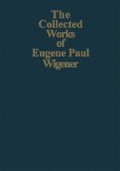Abstract
The possibility of formulating a classical relativistically invariant mechanics of an arbitrary number of interacting point particles is demonstrated. This theory is similar to Newtonian mechanics inasmuch as the interaction between any pair of particles contains an arbitrary function of their distance. The conservation laws for energy and linear and angular momenta are established in the sense that the sum of these quantities for the particles entering a collision is equal to the corresponding sum for the collision products. The possibility of such a mechanics contrasts with the impossibility, demonstrated recently, of establishing a relativistic mechanics within the framework of the canonical representations of the Lorentz group.
Access this chapter
Tax calculation will be finalised at checkout
Purchases are for personal use only
Preview
Unable to display preview. Download preview PDF.
References
L. D. Landau and E. Lifshitz, The Classical Theory of Fields, (Addison-Wesley Publishing Company, Inc., Cambridge, Massachusetts, 1951), p. 41.
D. G. Currie, T. F. Jordan, and E. C. G. Sudarshan, Rev. Mod. Phys. 35, 350 (1963); also D. G. Currie, J. Math. Phys. 4, 1470 (1963) and J. T. Cannon and T. F. Jordan, ibid. 5, 299 (1964); also H. Ekstein, Universit Ail-Marseille, 1964 (unpublished). These no interaction theorems apply to Diracs Hamiltonian framework, given in Rev. Mod. Phys. 21, 392 (1949). In this framework, Lorentz transformations are canonical transformations. The no interaction theorem can be circumvented if one is willing to give up the existence of world lines, as was done by L. H. Thomas, Rev. Mod. Phys. 17, 182 (1945); B. Bakamjian and L. H. Thomas, Phys. Rev. 92, 1300 (1953); L.L. Foldy, ibid. 122, 275 (1961)
By eliminating the electromagnetic field from the equations, Sommerfeld obtained equations of motion of this type for a pair of charged particles. These equations are manifestly Lorentz-invariant, but the conservation laws are not satisfied. The last statement is not surprising: One expects the particles to radiate. See J. L. Synge, Classical Dynamics in Handbuch der Physik, edited by S. Flugge (Springer-Verlag, Berlin, 1960), Vol. III/1, p. 11, also froc. Roy. Soc. (London) 177, 118 (1941); W. Pauli, Enz. d. ifalh. IViss. (G. B. Teubner, Berlin, 1921), Vol. V2, p. 645 (English transi.: Pergamon Press, Inc., New York, 1958, p. 92); A. Sommerfeld, Ann. Phys. Lpz. 33, 665 (1910); A. D. Fokker, Z. Physik 58, 386 (1929). Similar remarks apply to the very interesting considerations of P. Havas, Rev. Mod. Phys. 36, 938 (1964).
That such an interaction does not conflict with causality has been pointed out repeatedly. See e.g., P. Havas and J. Plebansky, Bull. Am. Phys. Soc. 5, 433 (1961); D. S. Currie, Ref. 1; P. Havas, Proceedings of the International Congress on Methodology and Philosophy of Science, Jerusalem, 1964 (to be published).
Cf. also the very penetrating considerations of J. A. Wheeler and R. P. Feynman, Rev. Mod. Phys. 17, 157 (1945).
Author information
Authors and Affiliations
Editor information
Editors and Affiliations
Rights and permissions
Copyright information
© 1997 Springer-Verlag Berlin Heidelberg
About this chapter
Cite this chapter
Van Dam, H., Wignert, E.P. (1997). Classical Relativistic Mechanics of Interacting Point Particles. In: Wightman, A.S. (eds) Part I: Particles and Fields. Part II: Foundations of Quantum Mechanics. The Scientific Papers, vol A / 3. Springer, Berlin, Heidelberg. https://doi.org/10.1007/978-3-662-09203-3_20
Download citation
DOI: https://doi.org/10.1007/978-3-662-09203-3_20
Publisher Name: Springer, Berlin, Heidelberg
Print ISBN: 978-3-642-08179-8
Online ISBN: 978-3-662-09203-3
eBook Packages: Springer Book Archive

